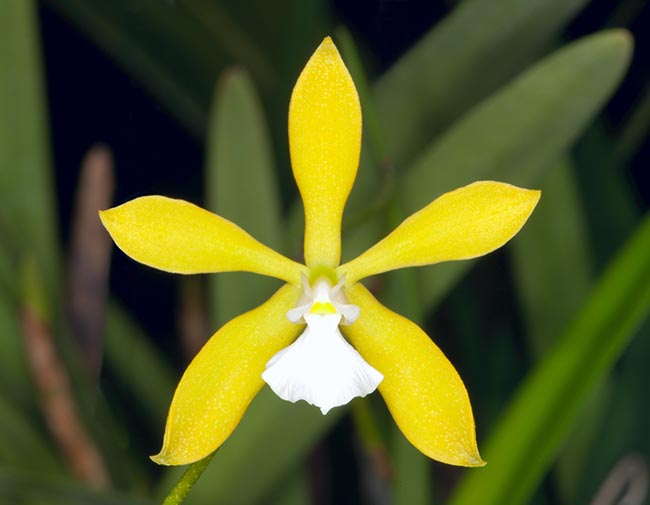Family : Orchidaceae

Text © Pietro Puccio

English translation by Mario Beltramini

Similar to butterflies, Encyclia tampensis flowers last even 7 weeks. Easy cultivation © Giuseppe Mazza
The name of the genus comes from the Greek verb “ενκυκλεω” = I encircle, with reference to the lateral lobes of the labellum surrounding the column; the name of the species “tampensis” = of Tampa, refers to the location where it was found and collected for the first time, Tampa Bay (Florida).
Common names: butterfly orchid, Florida butterfly orchid, onion orchid, Tampa butterfly orchid (English).
The Encyclia tampensis (Lindl.) Small (1913) is an epiphytic species with robust pseudobulbs, from ovoid to pyriform, close to each other, 2-8 cm long and of 1-2,5 cm of diameter, of green colour at times striated with purple, carrying in the terminal part a single leaf, rarely 2-3, coriaceous, from liner to linear-lanceolate, up to about 40 cm long and 0,5-2 cm broad.
The terminal inflorescence is racemose or paniculate on a brownish peduncle, up to about 80 cm long, carrying 3-45 flowers of 2,5-3,5 cm of diameter. The sepals and the petals have a much variable colour, from yellow to apple green to greenish brown; the sepals are oblong, 1,5-2 cm long and about 0,5 cm broad, the petals, from obovate to spatulate, are 1,5-2 cm long and 0,4-0,6 cm broad, the labellum is trilobed, 1,5-1,8 cm long, with ovate-triangular lateral lobes of white colour shaded of purple, roundish median lobe with wavy margins, usually white with magenta spot or striae; there is also a form with a wholly white labellum.
The flowers, which bloom mainly in spring-summer, are long-lasting, 5-7 weeks, emit a pleasant scent of honey during the afternoon hours and are pollinated by the bees. The fruits are ellipsoid, 1,7-2,7 cm long and 1,5 cm capsules. It reproduces by seed, in vitro, by micropropagation and by division, with each section provided with at least 3-4 pseudobulbs. Species easy to cultivate due to its adaptability in the wild to quite different environmental situations, tolerant of the brightness, as it can grow in shade as well as in full sun, the temperatures, being able to bear values around, or little under, the 0 °C for a few hours, and the humidity, thriving in constantly humid locations as well as in dry periods. In cultivation, it is better to keep the minimum temperatures constantly over the 14 °C, high humidity, 50-70%, with frequent waterings during the vegetative period, more spaced in winter.
For the watering and the nebulisations, rain water is to be utilized, or water by reverse osmosis, or demineralised; the fertilizations, duly distributed depending on the vegetative status of the plant and alternated, in way to avoid salts accumulation at the roots, are to be preferably done with hydrosoluble balanced products, with microelements, at ¼ of the dosage suggested on the package. It is to be mounted on bark, trunks, cork or arborescent ferns roots, or placed in low and wide baskets in order to allow the expansion without being disturbed, with much draining and aerated compost, that may be formed by medium-sliced bark fragments.
The species is reported in the appendix II of the CITES (species whose trade is internationally ruled).
Synonyms: Epidendrum tampense Lindl. (1847); Epidendrum tampense var. albolabium A.D.Hawkes (1950); Encyclia tampensis f. albolabia P.M.Br. (1995).
→ For general notions about ORCHIDACEAE please click here.
